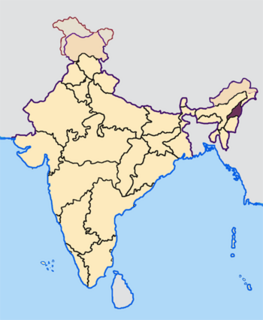
Senapati (Pron:/ˌseɪnəˈpʌti/) is a district of Manipur state in India.

Tamenglong district (Pron:/tæmɛŋˈlɒŋ/) is one of the districts of Manipur state in northeastern India.
The Kuki-Chin–Naga languages are a geographic clustering of languages of the Sino-Tibetan family in James Matisoff's classification used by Ethnologue, which groups it under the non-monophyletic "Tibeto-Burman". Their genealogical relationship both to each other and to the rest of Sino-Tibetan is unresolved, but Matisoff lumps them together as a convenience pending further research.
Maram tribe is one of the tribes that form the Naga tribe of Northeast India. The Marams occupy a large portion of Senapati district of Manipur. They are the only tribe of Nagas who did not consume pork in the past; today, with the advent of Christianity, they have started changing their food habit and now almost 99% of the Marams consume pork. The Marams are known for their rich cultural heritage: traditional attire, folk songs, folktales, musical instruments, and so on. There are more than 30 Maram villages scattered in the geographical expanse generally known as the Maram Area. As per the 2001 census, the Maram Nagas numbered about 37,340 in total. According to UNESCO database on endangered languages, the Maram Language was among the list which amounts to only 37,000 number of speakers. These figures, however, need further corroboration.
The Kabui are a major Naga tribe indigenous to Assam, Manipur and Nagaland in North-East India. The Kabui Naga are a scheduled tribe under the Constitution of India. The Kabui have a rich culture, customs and traditions.
The Sal languages are a branch of Sino-Tibetan languages spoken in eastern India, parts of Bangladesh, and Burma.

The Ao languages or Central Naga languages are a small family of Sino-Tibetan languages spoken by the Ao of north-central Nagaland in northeast India. Conventionally classified as "Naga", they are not clearly related to other Naga languages, and are conservatively classified as an independent branch of Sino-Tibetan, pending further research. There are around 607,000 speakers of the languages in total.
The Angami–Pochuri languages are a small family of Sino-Tibetan languages spoken in southern Nagaland and Northern Manipur of northeast India. Conventionally classified as "Naga", they are not clearly related to other Naga languages, and are conservatively classified as an independent branch of Sino-Tibetan, pending further research.
The Tangkhulic and Tangkhul languages are a group of Sino-Tibetan languages spoken mostly in northeastern Manipur, India. Conventionally classified as "Naga", they are not clearly related to other Naga languages, and are conservatively classified as an independent branch of Tibeto-Burman, pending further research.
The Kuki-Chin languages are a branch of 50 or so Sino-Tibetan languages spoken in northeastern India, western Burma and eastern Bangladesh. Most speakers of these languages are known as Kukī in Assamese and as Chin in Burmese; some also identify as Lushei. Mizo is the most widely spoken of the Kuki-Chin languages.
The Magar languages are a small proposed family of Sino-Tibetan languages spoken in Nepal, notably including Magar and Kham. (Ethnologue considers each to be a cluster of languages.) They are often classified as part of the Mahakiranti family, and Van Driem (2001) proposes that they are close relatives of Mahakiranti.

The Tibeto-Burman languages are the non-Sinitic members of the Sino-Tibetan language family, over 400 of which are spoken throughout the highlands of Southeast Asia as well as certain parts of East Asia and South Asia. Around 60 million people speak Tibeto-Burman languages, around half of whom speak Burmese, and 13% of whom speak Tibetic languages. The name derives from the most widely spoken of these languages, namely Burmese and the Tibetic languages . These languages also have extensive literary traditions, dating from the 12th and 7th centuries respectively. Most of the other languages are spoken by much smaller communities, and many of them have not been described in detail.

The Liangmai tribe inhabits Nagaland and Manipur states of Northeast India. The area of their domination spreads across Peren district in Nagaland state and Tamenglong, Senapati, Imphal East and Imphal West districts in Manipur. Dominating town of the Liangmais include Tening town, sub-division of Peren district of Nagaland state, and Tamei town, sub-division of Tamenglong district of Manipur state.
Khoirao also known as Thangal is a Sino-Tibetan language spoken in India.
Lui Ngai Ni is the seed-sowing festival celebrated by the Naga tribes of Manipur India. The festival heralds the season of seed sowing and marks the start of the year for the Nagas and the festival was declared a state holiday since 1988.





